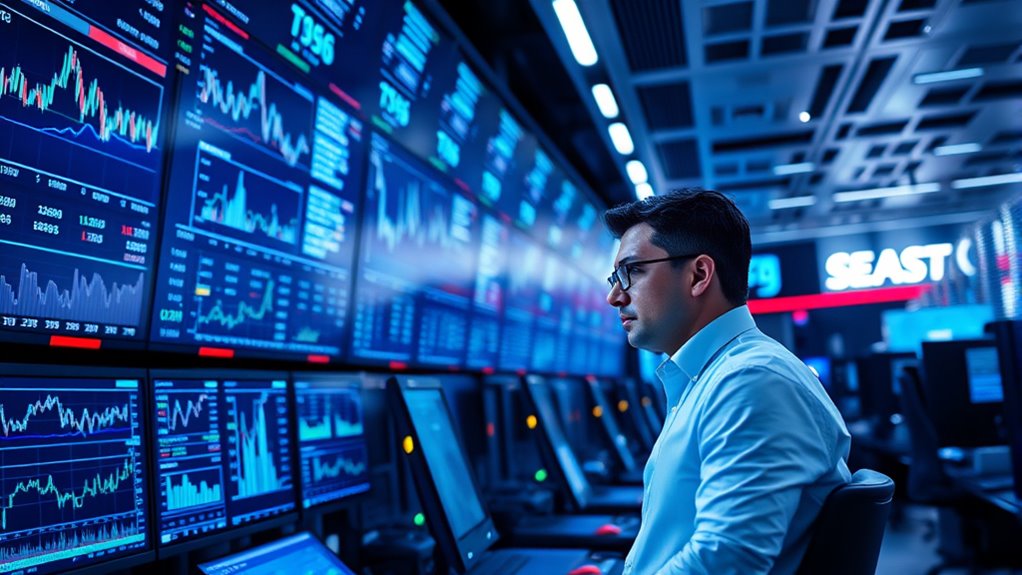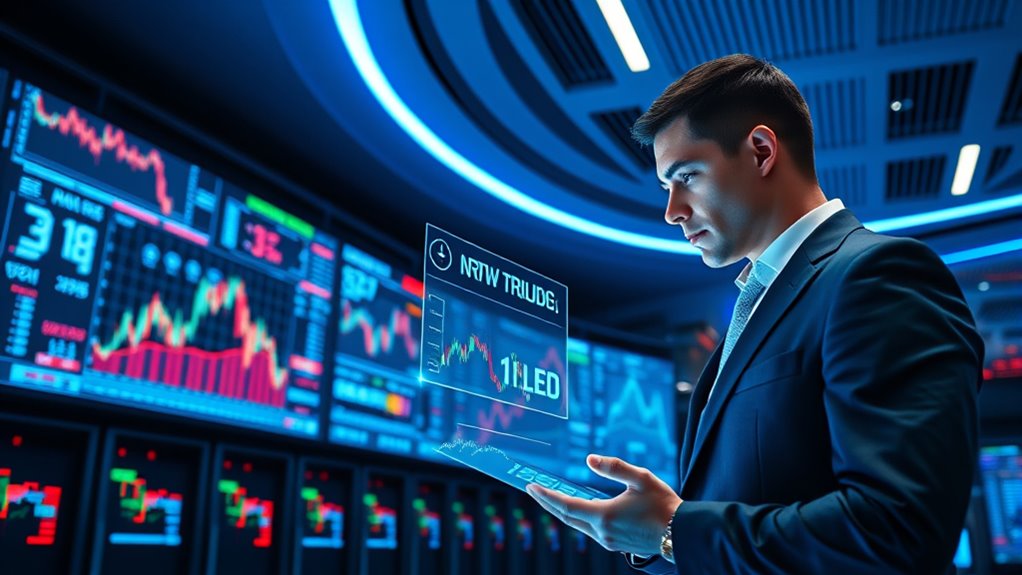AI now dominates finance by enabling faster, smarter algorithmic trading and improved risk management. It handles over 89% of global trades, offering real-time analytics, predictive models, and portfolio optimization. Advanced technologies like neural networks, natural language processing, and quantum computing boost decision-making and market insights. While AI offers operational advantages, it also brings risks like data quality and regulatory challenges. If you want to understand how AI continues to reshape finance’s future, keep exploring further.
Key Takeaways
- AI handles 89% of global trading volume, with advanced algorithms enabling real-time decision-making and adaptive strategies.
- Machine learning and neural networks improve market predictions, trend detection, and portfolio optimization.
- Data quality, cybersecurity, and system resilience are critical for reliable AI-driven trading operations.
- Transparent, explainable AI models and regulatory cooperation are essential for compliance and trust.
- Emerging technologies like quantum computing and decentralized AI are shaping the future of algorithmic trading and risk management.
The Rise of AI-Driven Trading Markets

The rise of AI-driven trading markets has transformed how financial transactions occur worldwide. You now benefit from faster, more efficient trade execution, with algorithms handling the bulk of transactions. AI drives an impressive 89% of global trading volume in 2025, showing its dominance across institutional and retail platforms. The market for algorithmic trading is projected to grow rapidly, reaching over $57 billion this year and expanding further through 2033. Cloud-based solutions are fueling this growth, offering scalability and cost savings. Today, algorithmic trading accounts for 60–70% of trades in major markets, underscoring AI’s central role. This evolution enables smarter decision-making, reduced costs, and improved market liquidity, shaping a new era of financial transactions driven by intelligent automation. Additionally, ongoing advancements in AI entertainment are influencing financial data analysis and visualization tools, making complex market insights more accessible to traders and investors. The integration of advanced analytics further enhances the precision and speed of these automated systems, solidifying AI’s position as a cornerstone of modern finance. As a result, the development of personality traits in AI systems is increasingly important to improve user trust and decision-making effectiveness in financial environments.
Core Technologies Empowering Modern Trading Platforms

Modern trading platforms rely on a combination of advanced technologies that enable automation, real-time analysis, and adaptive decision-making. You leverage tools like machine learning, neural networks, and real-time analytics to execute trades efficiently and manage risks dynamically. Machine learning replaces static rules with data-driven models that adapt to changing market conditions instantly. Leading platforms, such as JP Morgan’s LOXM and Nurp’s Intelligent Trader, offer multiple strategies tailored to current market states. Emerging technologies like deep learning, natural language processing, and quantum computing are pushing boundaries further.
- Machine learning for adaptive algorithms
- Neural networks for pattern recognition
- Real-time data analytics for instant decision-making
- Quantum computing for complex problem-solving
Strategic Advantages and Performance Enhancements

How does AI give traders a strategic edge in today’s markets? You benefit from real-time analytics that process vast amounts of data instantly, enabling faster decision-making and better timing. Predictive models help you identify emerging trends before they become obvious, giving you a competitive advantage. AI-driven algorithms optimize portfolios continuously, adjusting positions to maximize returns and minimize risks. Automated trading systems execute trades at the best prices, reducing transaction costs and slippage. Sentiment analysis from news and social media helps you gauge market mood, influencing your strategies. Incorporating yoga techniques can also improve trader focus and mental clarity, enhancing overall decision-making. Additionally, understanding specific vehicle tuning options, such as ECU remapping and suspension upgrades, demonstrates how technological enhancements can improve performance and efficiency—paralleling how AI optimizes trading strategies. Recognizing the importance of emotional support can help traders maintain mental resilience during volatile periods, improving their overall performance. Employing risk management techniques further safeguards your investments during unpredictable market swings. Leveraging AI security solutions can also protect your trading infrastructure from cyber threats that could disrupt your operations. Overall, AI enhances precision, speed, and adaptability, allowing you to outperform manual approaches and secure higher alpha in complex, fast-moving markets. This technological edge is transforming how you trade and manage risks effectively.
Navigating Risks and Operational Challenges

You need to address data quality concerns, as poor or biased data can lead to inaccurate trading decisions and increased risks. Building system resilience through robust infrastructure and contingency plans is essential to safeguard against outages and exploits. Additionally, understanding model interpretability issues helps you ensure transparency and trust in AI-driven strategies, especially during unexpected market shifts. Incorporating diversifying data sources can also serve as a metaphor for diversifying data sources to improve model robustness and reduce systemic risk. Recognizing the importance of regional flavors and traditions can offer innovative perspectives on managing dynamic and unpredictable environments in financial markets. Furthermore, fostering emotional safety within your systems can help mitigate unforeseen vulnerabilities and enhance overall stability.
Data Quality Concerns
Data quality remains a critical concern in AI-driven finance, as the effectiveness of algorithms depends heavily on the accuracy, completeness, and timeliness of the information they process. Poor data can lead to flawed decision-making, increased risk, and financial losses. You need to guarantee data integrity by addressing issues like:
- Incomplete or missing data points that skew analysis
- Outdated information causing delayed reactions
- Inconsistent formats that hinder integration
- Biases embedded in training datasets affecting model fairness
Ensuring proper data preparation is essential to prevent these issues from impacting model outcomes. Proper consistent messaging across data sources can help mitigate misinterpretations and errors. Failing to manage these challenges can cause models to malfunction or produce unreliable outputs. This can also undermine the psychological benefits of confidence and trust that stakeholders place in AI systems. It risks market stability and regulatory compliance. You must implement rigorous data validation, continuous monitoring, and cleansing protocols to maintain high-quality inputs. Additionally, understanding the importance of cybersecurity vulnerabilities is crucial, as they can compromise data integrity and expose sensitive financial information. Recognizing the trustworthiness of data sources and safeguarding data against external threats is vital for maintaining system integrity. Only then can AI systems deliver the precise, real-time insights necessary for effective trading and risk management.
System Resilience Strategies
Managing the operational risks of AI-driven trading requires robust resilience strategies that prioritize system stability and security. You need to guarantee your infrastructure can withstand unexpected disruptions and cyber threats. Regular stress testing and failover protocols help identify vulnerabilities before they cause outages. Implementing real-time monitoring allows you to detect anomalies early, enabling swift responses to potential issues. Redundancy in hardware, data feeds, and connectivity minimizes downtime and maintains trading continuity. Encryption and access controls safeguard sensitive information from malicious attacks. Additionally, establishing clear escalation procedures and backup plans ensures quick recovery during system failures. Incorporating cybersecurity measures is essential to defend against evolving threats, further strengthening your system’s resilience. Conducting thorough system testing can reveal hidden weaknesses that might compromise your operations during critical moments. Employing comprehensive risk assessments ensures you anticipate potential vulnerabilities and address them proactively. A well‑planned backup and recovery strategy is vital to quickly restore operations after an outage. Prioritizing resilience not only prevents costly outages but also maintains trader confidence and market integrity amid volatile conditions. Moreover, staying informed about threat intelligence helps adapt your defenses to emerging risks.
Model Interpretability Issues
While strengthening system resilience is essential for maintaining trading stability, understanding how AI models make decisions presents another significant challenge. Model interpretability is critical for validating trades, ensuring compliance, and building trust. Without clear explanations, you risk deploying opaque models that may produce unintended biases or errors. This can lead to regulatory scrutiny and operational failures. To address interpretability issues, focus on:
- Developing transparent algorithms that provide understandable outputs
- Using explainable AI techniques like feature importance and SHAP values
- Regularly validating models against market changes and biases
- Ensuring human oversight remains integral to decision processes
- Incorporating educational toys to foster better understanding of complex systems and promote transparency in AI decision-making. Additionally, integrating visual aids can help clarify complex model behaviors for stakeholders.
Regulatory Landscape and Transparency Initiatives

As AI-driven trading grows, you’ll need to navigate increasing regulatory oversight focused on transparency and fair market practices. Policymakers are working to establish mandates that guarantee algorithms operate ethically without giving unfair advantages or manipulating markets. Cross-border coordination becomes critical to manage the global nature of AI trading and prevent regulatory gaps.
Regulatory Oversight Challenges
Regulatory oversight of AI in finance presents significant challenges as the technology’s role in trading continues to expand rapidly. You must navigate complex issues like ensuring fair markets, preventing manipulation, and safeguarding investor interests. Regulators struggle to keep pace with innovation, often finding existing frameworks outdated or too slow. Transparency initiatives are evolving but face obstacles such as protecting proprietary algorithms and trade secrets. To address these challenges, regulators focus on:
- Developing real-time monitoring tools for algorithmic activity
- Setting standards for model explainability and auditability
- Coordinating across borders to manage cross-market risks
- Balancing innovation with risk mitigation without stifling growth
Your role involves understanding these evolving policies and ensuring compliance in a dynamic environment.
Transparency Mandates Progress
Have regulators made significant strides in implementing transparency mandates for AI-driven trading? Not quite yet, but progress is evident. Authorities are pushing for clearer disclosure of algorithmic decision processes and risk controls to protect market integrity. Some regulators are proposing mandatory reporting on model types, data sources, and decision logic, aiming to reduce opacity. Exchanges are also encouraging firms to adopt standardized documentation for their AI systems. However, balancing transparency with proprietary innovation remains a challenge. While efforts to increase oversight are gaining momentum, full transparency is still a work in progress, and many firms are cautious about revealing trade secrets. Overall, regulators are making headway, but exhaustive and enforceable transparency mandates will take more time to develop fully.
Cross-Border Coordination Efforts
Efforts to coordinate cross-border regulation of AI-driven trading are gaining momentum as markets become increasingly interconnected. You’ll find that regulators worldwide recognize the need for unified standards to manage risks and ensure transparency. They’re working to address challenges like differing legal frameworks, data sharing, and enforcement. Key initiatives include:
- Developing international guidelines for AI algorithm transparency
- Promoting real-time data sharing among jurisdictions
- Establishing joint oversight committees for cross-border monitoring
- Harmonizing rules to prevent regulatory arbitrage
These efforts aim to reduce market fragmentation and prevent regulatory gaps that could be exploited. You’ll see a push toward standardized reporting, collaborative investigations, and shared best practices. While progress is steady, aligning diverse regulatory landscapes remains complex and requires ongoing diplomatic and technical collaboration.
Future Directions in Algorithmic Trading and Risk Management

As technology continues to advance, the future of algorithmic trading and risk management will be shaped by emerging innovations like decentralized AI and quantum computing. These technologies promise faster, more secure, and more adaptive trading systems. Decentralized AI can reduce reliance on centralized servers, improving resilience and transparency, while quantum computing could revolutionize data processing speeds, enabling real-time analysis of complex markets. To illustrate, consider the potential impacts:
| Technology | Benefit | Challenge |
|---|---|---|
| Decentralized AI | Enhanced security and transparency | Integration complexity |
| Quantum Computing | Ultra-fast data analysis | Hardware and algorithmic stability |
| Hybrid Systems | Combining classical and quantum methods | Cost and scalability concerns |
These advancements will redefine risk management, emphasizing agility and robustness in an increasingly complex market environment.
Frequently Asked Questions
How Do AI Trading Algorithms Adapt to Unforeseen Market Shocks?
When unforeseen market shocks occur, AI trading algorithms adapt by quickly analyzing new data, adjusting their models, and recalibrating strategies in real time. You leverage machine learning to recognize emerging patterns and mitigate risks, enabling faster responses than humans. However, keep in mind that sudden, unprecedented events can still challenge AI’s predictive capabilities, so maintaining robust risk controls and human oversight remains essential for steering through unpredictable market shocks effectively.
What Measures Ensure AI Decision Transparency in High-Frequency Trading?
You can guarantee AI decision transparency in high-frequency trading by implementing explainability tools that clarify how algorithms make decisions. Regular audits and monitoring help you identify biases or errors. Maintaining detailed logs of trading activities provides accountability, while adhering to regulatory guidelines ensures compliance. Collaborate with developers to improve model interpretability and incorporate human oversight, which helps you verify AI actions, reduce risks, and build trust with stakeholders.
How Are Biases in Training Data Identified and Mitigated?
Biases in training data are like hidden landmines, waiting to explode in your AI system. You identify them by thoroughly analyzing data sources, checking for skewed representations, and monitoring model outputs for unfair patterns. Mitigation involves balancing datasets, applying fairness algorithms, and regularly retraining models with diverse data. This proactive approach helps guarantee your AI remains fair, accurate, and trustworthy, safeguarding your trading decisions from unintended prejudices.
What Are the Costs Associated With Deploying On-Premise AI Trading Systems?
Deploying on-premise AI trading systems costs you considerably, including high initial investments in hardware, software, and infrastructure setup. You’ll also face ongoing expenses for maintenance, upgrades, and security measures to protect sensitive data. Additionally, staffing skilled personnel to manage and optimize these systems adds to your costs. While on-premise provides control and security, it demands substantial resources, making it a costly but tailored solution for large institutions.
How Will Decentralized AI Impact Global Market Stability?
Decentralized AI could be a double-edged sword, like a wild stallion that’s hard to tame. It promises more resilient, transparent markets by reducing single points of failure. But, it could also stir chaos, amplifying volatility as multiple autonomous systems interact unpredictably. Your challenge lies in balancing innovation’s promise with safeguards to prevent a chaotic herd, ensuring the market remains a steady, functioning ecosystem amid the decentralized storm.
Conclusion
As you explore the rapid evolution of AI in finance, you realize the potential for game-changing breakthroughs is immense. But with new opportunities come uncharted risks and uncertainties. Will your strategies stay ahead of the curve or fall behind in this ever-shifting landscape? The future of algorithmic trading and risk management is unfolding fast—are you ready to navigate the challenges and open its full power? Stay tuned, because the next chapter is just beginning.









